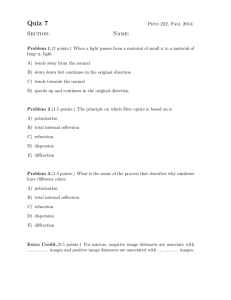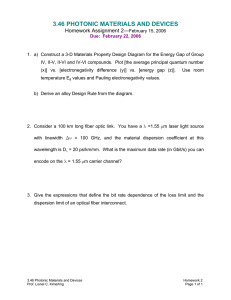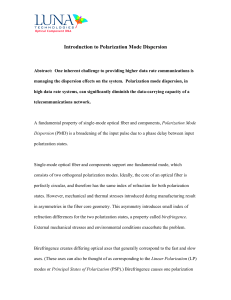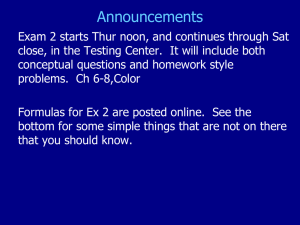Lecture 3 - Propagetion trhough optical fiber - Part II
advertisement
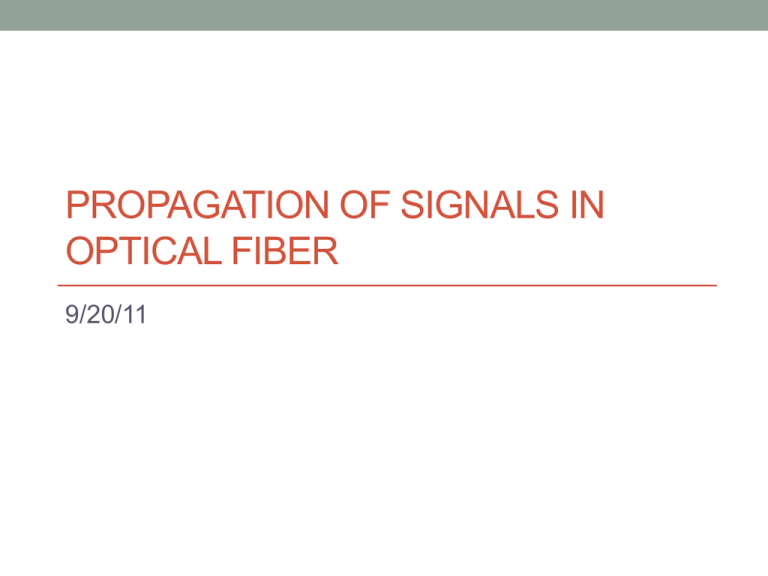
PROPAGATION OF SIGNALS IN OPTICAL FIBER 9/20/11 Light Characteristics • Particle Characteristics • Light has energy • Photons are the smallest quantity of monochromatic light • That is light with single frequency • The energy of a photon is described by E= hf (h=6.6260755E-34 joule-sec) and f is the frequency of light • Energy of light depends on its speed: E=mc^2 (Einstein’s Eqn.) • The relationship between frequency and speed: v=c/λ • Speed of light changes as it enters denser materials • Wave Characteristics • Described by a series of equations Photometric Terms • Flux • Rate of optical energy flow (number of photons emitted per second) • Illuminous density • Rate emitted in a solid angle Light Properties • Light is electromagnetic radiation • Impacted by many parameters: reflection, refraction, loss, polarization, scattering, etc. • Light of a single frequency is termed monochromatic • Any electromagnetic wave is governed by a series of equations • In this case ε and μ are relative ** Wave Equation • Phase velocity • Group velocity • Velocity at which pulses propagate: 1/β1 • Change of rate of group velocity is proportional to β2 • When β2=0 pulse does not broaden! Propagation constant for monochromatic wave • Defined by β=ωn/c = 2πn/λ = kn • k is the wave number k=2π/λ (spatial frequency) • Thus, for core β1 = k.n1 • That is kn2 < β <kn1 • Effective index = neff = β/k • The speed at which light travels is c/neff Polarization • Remember: light is an electromagnetic wave • Electric field and magnetic field • When E and H fields have the same strength in all directions light is un-polarized • As light propagates through medium field interact and their strengths changes light become polarized • If the E field associate with the EM wave has no component in the direction of propagation is said to be Traverse E-field (TE) • Thus, only Ex and Ey exist n the fundamental mode • Same for TM • Collectively, it is called a TEM wave Directional Relation Between E and H For Any TEM Wave k (x,y,z) E (x,y,z) H (x,y,z) Phasor Form Note: E and H may have x & y components However, they travel in Z direction and They are perpendicular to each other! Polarization - General • Polarization is the orientation of electric field component of an electromagnetic wave relative to the Earth’s surface. • Polarization is important to get the maximum performance from the propagating signal • There are different types of polarization (depending on existence and changes of different electric fields) • Linear • Horizontal (E field changing in parallel with respect to earth’s surface) • Vertical (E field going up/down with respect to earth’s surface) • Dual polarized • Circular (Ex and Ey) • Similar to satellite communications • TX and RX must agree on direction of rotation • Elliptical • Linear polarization is used in WiFi communications Polarization - General (x,z) z E-Field is Going up/down respect to Earth! (Vertical Polarization) (y,z) E-Field is Rotating (or Corkscrewed) as they are traveling Propagating parallel to earth Polarization is important to get the maximum performance from the antennas The polarization of the antennas at both ends of the path must use the same polarization This is particularly important when the transmitted power is limited Factors Impacting Polarization • A number of factors can impact polarization • Reflection • Refraction • Scattering • These factors in turn depend on material property • Transparent materials • Isotropic • Refractive index, polarization, and propagation constant do not change along the medium • Anisotropy • Electrons move with different freedom in different directions • As light hits the medium the refracted light splits, each having a different polarization • This property is referred to as Birefringence in fiber – modes of propagation have different propagation constants (polarization modes Ex & Ey) • Birefringence in fiber can be used for filtering Example – Fiber Birefringence • The birefringence property pulse spreading • Lithium Niobate • We refer to this as polarization-mode dispersion Numerical Example – Fiber Birefringence Dispersion • Different components of light travel with different velocity , thus, arriving at different time • This results in pulse broadening • Dispersion types • Polarization Mode Dispersion • Intermodal Dispersion • Chromatic Dispersion Chromatic Dispersion • So how much a pulse is broadened? • Depends on the pulse shape • Let’s assume a specific family of pulses called chirped Gaussian Pulses (chirped means frequency is changing with time) • They are not rectangular! • Used in RZ modulation • Chirped pulses are used in high-performance systems • If To is the initial width, Tz is pulse width after distance z, with κ being the chirp factor: Tz kb2 z 2 b2 z 2 = (1+ 2 ) + ( 2 ) To To To Chromatic Dispersion • In a single mode fiber different spectral components travel with different velocities (proportional to β2) • Chromatic Dispersion parameter D = 1(2πc/λ^2)β2 • Expressed in terms of ps/nm-km • No chromatic dispersion when β2 = second derivative = 0 • D=Dm + Dw • Due to material dispersion nλ • Different wavelengths travel at different speeds • More significant • Due to waveguide dispersion n2<neff<n1; Pneff • neff depends on how propagated power is distributed in cladding or core • Power distribution in core and cladding is a function of wavelength • Longer wavelength more power in cladding • Thus, even if n(λ) = constant wavelength change result in power distribution change neff change • Chromatic Dispersion The total dispersion D is zero about 1.31 um We want to operate around 1.55um (low loss) let’s shift the zero-dispersion point to 1.55um! This is done by changing Dw (Dm cannot be changed too much) Negative dispersion Example • Consider a 2.5 Gb/s SONET system operating over a single mode fiber at 1.55 um with dispersion length of 1800 km. Find Tz/To after Z = 2LD. Assume an unchirped Gaussian pulse • LD = To^2/β2 • Z=2(LD) Tz/To = sqrt(1+4)=2.24 • Note To=0.2 nsec (half bit interval) • What if κ is negative? Tz kb2 z 2 b2 z 2 = (1+ 2 ) + ( 2 ) To To To Chirp Factor • If chirp factor is negative the pulse goes under compression first and then it broadens Example of Single Mode Chromatic Dispersion Dealing with Dispersion • Different approaches • Dispersion-shifted Fiber • Dispersion Compensated Fiber • Dispersion Flattened Fiber • Basic idea • Change the refractive index profile in cladding and core • Thus introducing negative dispersion References • http://www.gatewayforindia.com/technology/opticalfiber.ht m • Senior: http://www.members.tripod.com/optic1999/
